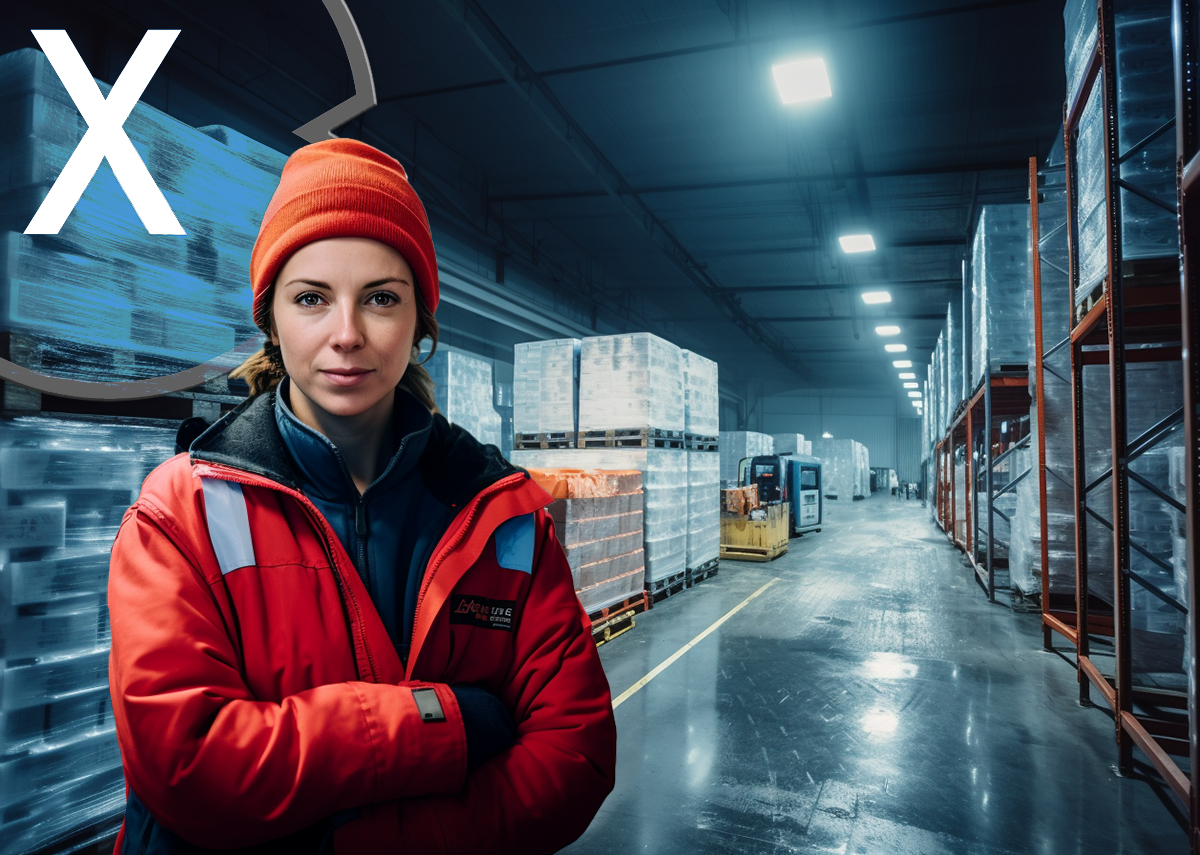
Risk management in the cold chain: How can failures and loss of quality be avoided? – Image: Xpert.Digital – AI & XR 3D Rendering Machine (art photo/AI)
🧊🔒 Risk management in the cold chain: Strategies to avoid failures and loss of quality in fresh and refrigerated logistics 🚚🧑🔬
Maintaining an uninterrupted cold chain is crucial for the quality and safety of perishable foods and other sensitive products. From production to processing and transportation to delivery to the consumer, each stage poses its own risks that must be addressed with effective risk management. This text provides an overview of the challenges in cold chain risk management and shows practical solutions to avoid failures and maintain product quality.
🚫 Identification of risks in the cold chain
To manage risks effectively, they must first be identified. In the cold chain, such risks can be diverse: technical defects, human error, environmental factors, logistical errors or sudden fluctuations in demand. A careful analysis of the entire supply chain is essential to identify potential vulnerabilities. This includes checking all devices and processes for reliability, questioning processes and constantly monitoring external factors such as weather conditions or traffic flow.
🌐 Technological solutions
Modern technologies play a major role in risk management in the cold chain. Advanced cooling devices with self-regulating cooling systems and alarm functions can help prevent temperature fluctuations. Real-time temperature monitoring using Internet of Things (IoT) devices makes it possible to track temperature throughout transport and proactively respond to deviations. In addition, the use of blockchain technology can bring increased transparency and traceability to the supply chain, which both increases consumer trust and helps identify and resolve problems.
🎓 Training and human resources management
The competence and commitment of the staff are also critical components in cold chain risk management. Regular training and education to raise awareness of the importance of cold chain integrity and the correct handling of products and cooling systems is essential. In addition, clear communication and the definition of responsibilities ensure that everyone involved knows their tasks and acts accordingly.
🛠️ Preventive maintenance and infrastructure
A well-maintained infrastructure is the basis of reliability in the cold chain. Preventive maintenance of vehicles, refrigeration equipment and warehouses can predict and therefore reduce failures. Strict hygiene and safety protocols ensure that products are not compromised in quality due to contamination or other hazards.
📝 Strategic planning and flexibility
Strategic planning, including a detailed risk analysis, helps to run through possible scenarios and develop emergency plans. In addition, the chain should be designed to be flexible enough to respond to unforeseen events such as natural disasters or geopolitical changes. This also includes the diversification of supply sources and transport routes as well as the possibility of using alternative storage or distribution centers.
💼 Partnerships and collaboration
Close cooperation between everyone involved in the cold chain - from producers to logistics service providers to retailers - is fundamental for strong risk management. Transparent communication, common objectives and agreed standards help to view the chain as a unified whole and to act in harmony. Partnerships can also help share infrastructure investments and develop joint emergency response strategies.
📜 Legal requirements and certifications
Compliance with legal requirements and obtaining certifications, such as ISO standards for cold storage, are not only legally required, but also serve as evidence of reliability and quality assurance. Companies should always be informed about the latest regulations and adapt their processes accordingly.
📊 Risk management software
The use of specialized risk management systems allows data to be collected, analyzed and visualized, simplifying decision-making and reducing response time to problems. Such systems can also be used to carry out regular risk assessments to ensure that all measures remain current and effective.
🔑 The key to success
Risk management in cold and fresh logistics is a complex but essential undertaking that requires constant attention and innovation. The key to success lies in a holistic approach that includes technology, training, preventive maintenance, strategic planning, partnership and compliance. In this way, failures can be minimized and loss of quality avoided, which not only increases consumer satisfaction, but also helps companies strengthen their market position and remain successful in the long term.
📣 Similar topics
- 📣 Risk management in the cold chain: challenges and solutions
- 🧊 From production to delivery: risk management in the cold chain
- 🚚 Practical strategies to avoid failures in refrigerated logistics
- 🌡️ Risk factors in the cold chain: identification and prevention
- 💻 Technology and cold chain: Effective risk management through IoT and blockchain
- 📚 Training and human resources management: Key components in cold chain risk management
- ⚙️ Maintenance and infrastructure: Predictive measures against failures in the cold chain
- 🗺️ Flexible risk management in the cold chain: planning for unforeseen events
- 👥 Partnerships and collaboration: Strengthening risk management in the cold chain
- ✅ Legal requirements and certifications: Guidelines for reliable refrigerated logistics
#️⃣ Hashtags: #risk management #cold chain #refrigerated logistics #quality assurance #efficiency
🧊 Technology leader Japan in refrigerated logistics – better working conditions optimize distribution processes
Refrigerated logistics/fresh logistics: Cold storage with automated material flow optimizes distribution processes - Image: Xpert.Digital
Asian countries such as Japan in particular are considered pioneers here. Tokyo, one of the largest cities in the world with over 38 million inhabitants, impressively shows how high population density and quality of life can be combined with the help of innovative urban and infrastructure planning. The expansion of efficient transport and supply systems has been the focus here for decades.
More about it here:
Xpert partner in warehouse planning and construction
🌍📦 Adaptation to climate change 🌡️🌪️🌊
Climate change poses an additional challenge for the cold chain. Extreme weather conditions such as heat, storms or floods can lead to interruptions. It is therefore important that companies adapt their risk management strategies to climate change. This could include building more robust warehouses, selecting temperature-resistant packaging, or setting up refrigeration facilities in strategic, less vulnerable locations.
🔌💰 Energy and cost efficiency 💡💲
Efficiency is another key aspect of cold chain risk management. The use of energy-efficient cooling systems and the use of alternative energies, such as solar energy for cooling equipment, help reduce operational load and environmental impact. This is not only for reasons of sustainability, but also to reduce operating costs in the long term and thus minimize economic risks.
📊🧠 Use of data analysis and artificial intelligence 🖥️🤖
Big data and artificial intelligence (AI) offer unimagined possibilities in risk management. Big data analysis can detect patterns and identify predictable problems before they happen. Artificial intelligence can be used to optimize supply chains and predict fluctuations in demand, increasing planning security and avoiding overproduction or storage.
📦🛡️ Robust packaging solutions 🛡️📦
Choosing the right packaging plays a central role in protecting goods during transport. Insulation materials and techniques that can withstand even extreme conditions are critical to maintaining product integrity. The development of innovative packaging solutions that are both sustainable and high-performance is a dynamic field that continuously contributes to minimizing risks in the cold chain.
🚨📢 Crisis communication 📲🔄
Effective crisis communication is another pillar of risk management. In the event of a failure or loss of quality, it is important to communicate quickly and transparently, both internally and to customers and the public. This helps maintain trust and shows that the company is acting responsibly and proactively.
🔒📋 Quality assurance and control 👨🔬✅
Regular quality controls are essential for maintaining standards in the cold chain. By implementing strict quality assurance systems and regular audits, companies can uncover vulnerabilities and quickly address irregularities. This is particularly important with regard to food safety, where compliance with HACCP (Hazard Analysis and Critical Control Points) guidelines is essential.
🆘🛡️ Emergency preparedness and insurance coverage 🚑📄
Despite all preventative measures, incidents cannot always be completely prevented. It is therefore important to have emergency plans in place that enable a quick response. This also includes adequate insurance coverage that covers the financial consequences of failures and helps to ensure the continuity of business operations.
🏢📈 Culture of continuous improvement 🌱🚀
Establishing a corporate culture that promotes continuous improvement and innovation is essential for long-term risk management. Employees should be encouraged to suggest improvements and drive innovation. This creates an environment where proactive risk management becomes part of daily business.
🚧🔒 Risk management 🧊🔒
Risk management in cold and fresh logistics is a multifaceted task that requires a holistic approach. It's about thinking ahead, planning and constantly improving processes in order to reduce the risk of failures and loss of quality. By using cutting-edge technologies, fostering a strong corporate culture focused on safety and quality, and developing long-lasting partnerships and networks, cold chain companies can minimize risks and meet the challenges of a rapidly changing world. The key to success lies in flexibility and adaptability to respond to internal and external changes, always with the aim of ensuring the safety and freshness of the products to the end consumer.
📣 Similar topics
- 🌡️ Climate change and the cold chain: adaptation strategies 🏭🌍
- 🔌 Energy efficiency in the cold chain: Sustainable solutions 💡💰
- 🖥️ Data analysis and AI in the cold chain: Optimized supply chains 📊🤖
- 📦🛡️ Ensure product integrity: Robust packaging solutions 🚧📦
- 📢 Communication in crisis situations: maintaining trust 🚨📣
- 👨🔬 Quality assurance in the cold chain: maintaining standards ✅🔒
- 🚑 Emergency preparedness and insurance protection in the cold chain 🆘🛡️
- 🌱 Corporate Culture of Improvement: Innovation and Risk Management 🏢🚀
- 🧊 Success factor risk management in the cold chain: flexibility and adaptability 💼🧊
- 🌍🚧 Cold chain and risk management: challenges and solutions 🌡️🔒
#️⃣ Hashtags: #climate change #energy efficiency #data analysis #packaging solutions #quality assurance
Xpert.Plus warehouse optimization - high-bay warehouses such as pallet warehouses consulting and planning
We are there for you - advice - planning - implementation - project management
☑️ Smart City & Factory: Industry expert for energetic 5G buildings and halls as well as advice and installation of solar systems
☑️ Xpert.Plus - logistics consulting and logistics optimization
☑️ Industry expert, here with his own Xpert.Digital Industry Hub with over 2,500 specialist articles
I would be happy to serve as your personal advisor.
You can contact me by filling out the contact form below or simply call me on +49 89 89 674 804 (Munich) .
I'm looking forward to our joint project.
Xpert.Digital - Konrad Wolfenstein
Xpert.Digital is a hub for industry with a focus on digitalization, mechanical engineering, logistics/intralogistics and photovoltaics.
With our 360° business development solution, we support well-known companies from new business to after sales.
Market intelligence, smarketing, marketing automation, content development, PR, mail campaigns, personalized social media and lead nurturing are part of our digital tools.
You can find out more at: www.xpert.digital - www.xpert.solar - www.xpert.plus
Industrial & B2B Business Metaverse: Reduce costs with XR technology for photorealistic product images (XR 3D rendering machine)
XR technology offers a superior solution for creating photorealistic images and allows companies to free themselves from the expensive fees of external media agencies. It is common knowledge that media agencies charge high costs to create such images as it requires expertise, special software and collaboration with various experts.
More about it here:

